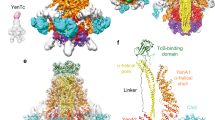Abstract
Colicins are antibiotic proteins produced by and active against sensitive Eschericia coli and closely related bacteria. They can adsorb to specific receptors located at the external surface of the outer membrane of sensitive cells, and are then translocated to their specific targets within these cells. The largest group of colicins comprises those which can form voltage-dependent channels in membranes, thereby destroying the cell's energy potential1. Colicin molecules are organized in structural domains, each domain carrying one function associated with the toxin's lethal activity. The pore-forming activity seems to be located at the carboxyl terminus. A thermolytic fragment comprising amino acids 389–592 from colicin A has pore-forming properties very similar to those of the entire molecule. This fragment is soluble in aqueous medium and spontaneously inserts into lipid bilayers2. We have determined the structure of the pore-forming fragment of colicin A by X-ray crystallography and refinement at 2.5 Å resolution. The protein consists of ten α-helices organized in a three-layer structure. Two of the helices are completely buried within the structure and form a hydrophobic hairpin loop similar to that proposed for signal sequences which function in translocation. We present a model for insertion of the protein into lipid bilayers the features of which may be applicable in other biological systems involving protein insertion or translocation across membranes.
This is a preview of subscription content, access via your institution
Access options
Subscribe to this journal
Receive 51 print issues and online access
$199.00 per year
only $3.90 per issue
Buy this article
- Purchase on Springer Link
- Instant access to full article PDF
Prices may be subject to local taxes which are calculated during checkout
Similar content being viewed by others
References
Lazdunski, C. et al. Biochim. biophys. Acta 947, 445–464 (1988).
Collarini, M., Amblard, G., Lazdunski, C. & Pattus, F. Eur. biophys. J. 14, 147–153 (1987).
Tucker, A. D., Pattus, F. & Tsernoglou, D. J. molec. Biol. 190, 133–134 (1986).
Howard, A. L. et al. J. appl. Crystallogr. 20, 383–387 (1987).
Wang, B. C. in Meth. Enzym. 115, 90–112 (1985).
Leslie, A. G. W. Acta crystallogr. A43, 134–136 (1987).
Brünger, A. T., Kuriyan, J. & Karplus, M. Science 235, 458–460 (1987).
van Gunsteren, W. F. Protein Eng. 2, 5–13 (1988).
Hendrickson, W. A. & Konnert, J. H. Biomolec. Struct. Funct. conform. Evol. 1, 43–57 (1981).
Cavard, D. et al. Eur. J. Biochem. 172, 507–512 (1988).
Remington, S., Wiegand, G. & Huber, R. J. molec. Biol. 158, 111–152 (1982).
Pattus, F., Keitz, F., Martinez, C., Provencher, S. W. & Lazdunski, C. Eur. J. Biochem. 152, 681–689 (1985).
Pattus, F. et al. Biochemistry 22, 5698–5703 (1983).
Cleveland, M. B., Slatin, S., Finkelstcin, A. & Levinthal, C. Proc. natn. Acad. Sci. U.S.A. 74, 2589–2593 (1977).
Baty, D. et al. Proc. natn. Acad. Sci. U.S.A. 84, 1152–1156 (1987).
Liu, Q. R. et al. Proteins 1, 218–229 (1986).
Lunn, C. A., Takahara, M. & Inouye, M. Meth. Enzym. 125, 18–149 (1986).
Engelman, D. & Steitz, T. A. Cell 23, 411–422 (1981).
Schleyer, M. & Neupert, W. Cell 43, 339–350 (1985).
Eilers, M. & Schatz, G. Nature 332, 228–232 (1986).
Randall, L. L. & Hardy, S. J. S. Cell 46, 921–928 (1986).
Zimmermann, R. & Meyer, D. I. Trends biochem. Sci. 11, 512–515 (1986).
Vestweber, D. & Schatz, G. EMBO J. 7, 1147–1151 (1988).
Eilers, M., Hwang, S. & Schatz, G. EMBO J. 7, 1139–1145 (1988).
Bhakdi, S. & Tranum-Jensen. J. Rev. Physiol. Biochem. Pharmac. 107, 148–106 (1987).
Wickner, W. Biochemistry 27, 1081–1086 (1988).
Lesk, A. M. & Hardman, K. D. Science 216, 539–540 (1982).
Author information
Authors and Affiliations
Rights and permissions
About this article
Cite this article
Parker, M., Pattus, F., Tucker, A. et al. Structure of the membrane-pore-forming fragment of colicin A. Nature 337, 93–96 (1989). https://doi.org/10.1038/337093a0
Received:
Accepted:
Issue Date:
DOI: https://doi.org/10.1038/337093a0
This article is cited by
-
The P. aeruginosa effector Tse5 forms membrane pores disrupting the membrane potential of intoxicated bacteria
Communications Biology (2022)
-
Cholesterol-dependent cytolysins: from water-soluble state to membrane pore
Biophysical Reviews (2018)
-
Pore-forming toxins: ancient, but never really out of fashion
Nature Reviews Microbiology (2016)
-
Binding of a novel bacteriostatic agent—chitosan oligosaccharides–kojic acid graft copolymer to bovine serum albumin: spectroscopic and conformation investigations
European Food Research and Technology (2015)
-
More Than a Pore: The Interplay of Pore-Forming Proteins and Lipid Membranes
The Journal of Membrane Biology (2015)
Comments
By submitting a comment you agree to abide by our Terms and Community Guidelines. If you find something abusive or that does not comply with our terms or guidelines please flag it as inappropriate.



